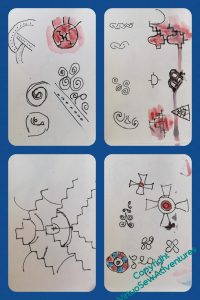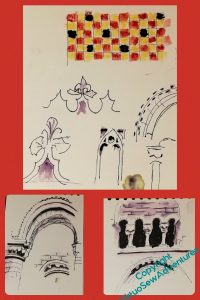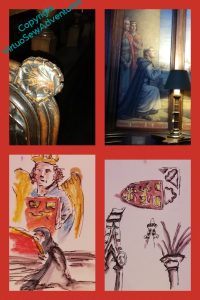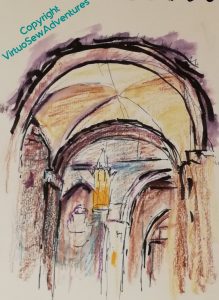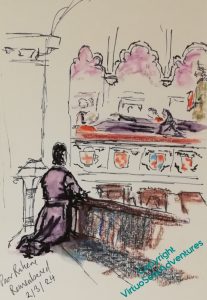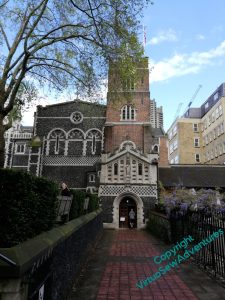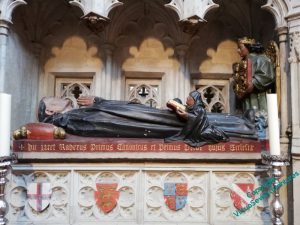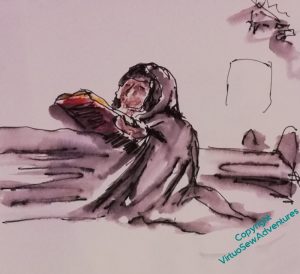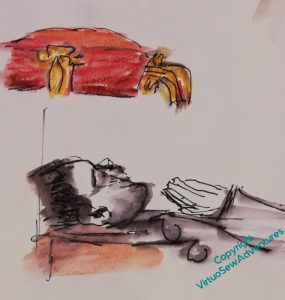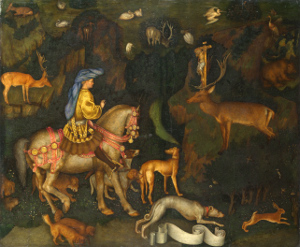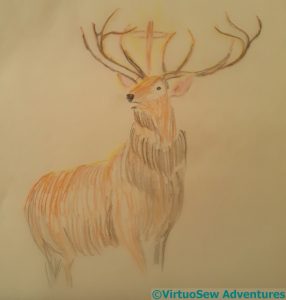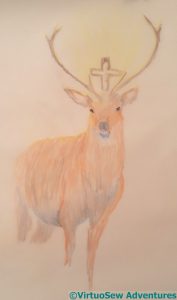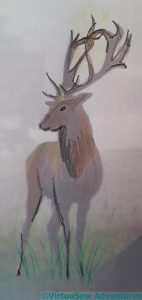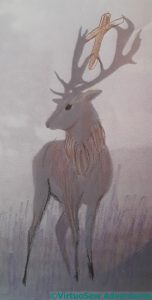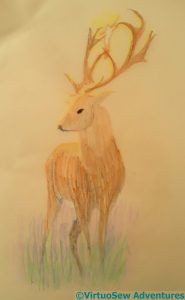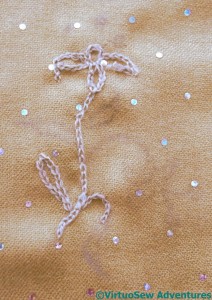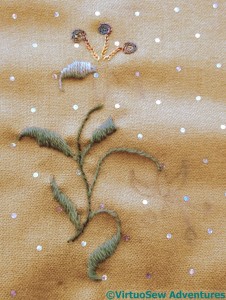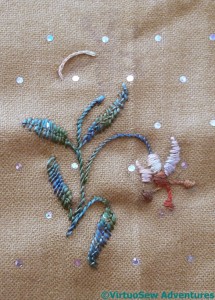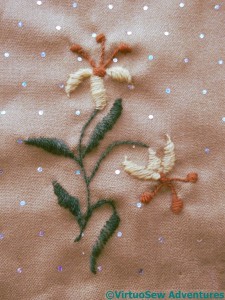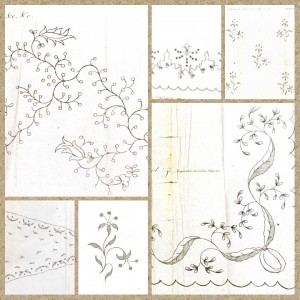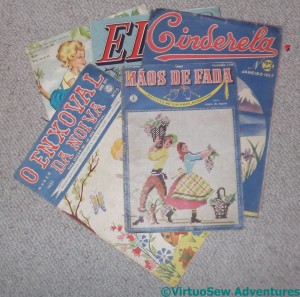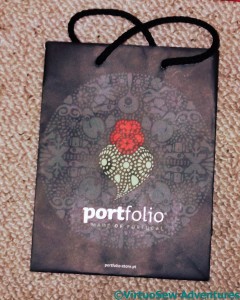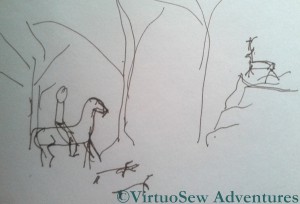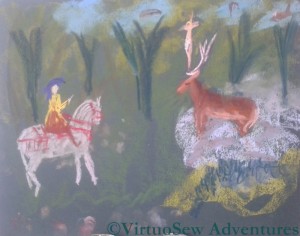Tag: Research
Research for Aethelflaed
I think I’m going to try to do Aethelflaed next.
At the moment, my thought is to have her riding (side-saddle) towards the refortification works at Chester (which is where I grew up). I looked up “side-saddle”, owing to having some doubts about how recent or not it might be, and the history and techniques of riding sidesaddle seem more complex than would at first appear.
Of course they are.
There’s the technique you probably think of first, with a leg hooked up and the rider facing forwards (think Queen Elizabeth II riding Burmese to Trooping The Colour, way back when). The development of that design is credited to Anne of Bohemia, Richard II’s Queen, so it would be anachronistic, to say the least, for Aethelflaed. However… The older style is more like a chair set on the horse’s back, with a footboard, and the rider faces sidesways. Generally the horse is then lead, either by a someone on foot, or by another rider, but I simply cannot imagine Aethelflaed not being under her own steam, as it were. I suspect that she would just have a really voluminous skirt or a slit skirt or even just wear men’s clothing and ride astride. But that would not create the image I want, so I’m going to have to balance storytelling with other concerns. Well, that’s part of what is interesting to me, so that’s ok!
I had a lovely day out a little while ago to see the Staffordshire Hoard exhibition at the Museum in Stoke on Trent. It’s the closest source I can find for patterns that I might be able to use, and although none of these sketches or photos will be useable directly, I can, for example, imagine taking the style of that processional cross in the grid at the top, sketched in the grid to the side here, and using that at the cardinal points of the border.
I’m also wondering about taking one of the patterns from the pieces in the Hoard, and turning it into a border design, somehow. That might make everything a bit busy, so, more thought needed…
Research for Rahere
I had another chance to go to the Church of St Bartholomew The Great in Spitalfields recently, and managed to get in a solid couple of hours of sketching and thinking while I was about it. I did attract a bit of attention – someone came and asked whether they could take my photo as I sketched, and even photographed the sketch itself, but it was in the morning on a cold and wet Saturday, so there wasn’t too much activity. By the time the tour groups started to come in and obscure what I wanted to sketch, I was becoming chilled and clumsy and in need of food and a hot cup of tea.
I might use that coloured tile pattern in the border of Rahere’s panel, instead of a plain colour. I think I’d want to make the colours closer, to create the effect of a rich damask-type fabric, but I feel a bit wider variation is needed among the four panels. I want each of them to stand alone, but if they end up displayed together, they need to look happy…
I had been wondering whether it would be legitimate to include scallop shells in the borders, to reference pilgrimage, since most often I have heard of the scallop shell being associated with the Camino to Compostela. Plainly the makers of the pews thought so!
I’m still trying to work out what to set behind Rahere. Arches? A single arch, maybe, with the gold underside couching within. That may be a bit too reminiscent of a halo, and no-one, as far as I know, has ever even suggested Rahere as a candidate for sainthood. If Kipling’s version of him has any veracity (it’s certainly not based on research – you might call it a possible emotional truth), he’s very much in the category of people who make for an challenging example – speaking truth to power is not a gift we all have, although we may all agree that it is important that it happens.
In truth I think he’s more valuable as an example to follow without the accolade. He is credited with founding an institution which continues to provide healthcare, 900 years after foundation, he is still remembered, and no one suggests that what he did is the less valuable for the lack of a sainthood.
As you see – he is still remembered.
Researching Rahere
A journey through London gave me the opportunity to visit the Church of St Bartholomew The Great in Smithfield, which is indeed very close to the Hospital Rahere founded, known today as St Barts.
It, and Rahere himself, have had varying fortunes and visibility over the years, and, for example, Rahere’s tomb was built in the fifteenth century, nearly four centuries after his death.
I haven’t yet discovered whose shields are displayed there, but it seems likely I will. The Rector was involved in a wedding rehearsal when I arrived, but I carried on quietly sketching and walking around the Church, staying out of the way as best I could while still continuing to work.
And I had my reward in due course, when, on the principle that Bairns As Don’t Ask, Don’t Get, I tracked him down afterwards and asked what, if any, information they had on Rahere and the early days of his foundation.
I may have bewildered him slightly – I have the impression that’s not the first thing people usually say! – but he took it well, and informed me that as this year is the anniversary of the foundation, a substantial History has been produced. So when that arrives, I shall have more to say on the subject, I’m sure!
Textile Tours of Paris
A little while ago, we were in Paris – a trip planned last year, and carried on with, sanitiser in hand, in spite of the certainty of quarantine when we got home.
Amid a variety of adventures (we were staying with family) we went on a Textile Tour of Paris with Rebecca Devaney.
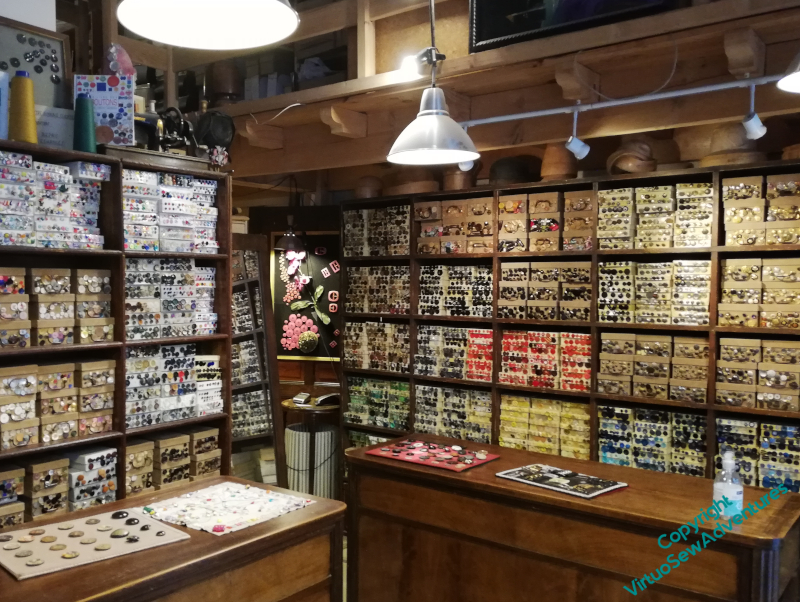
Ultramod – buttons 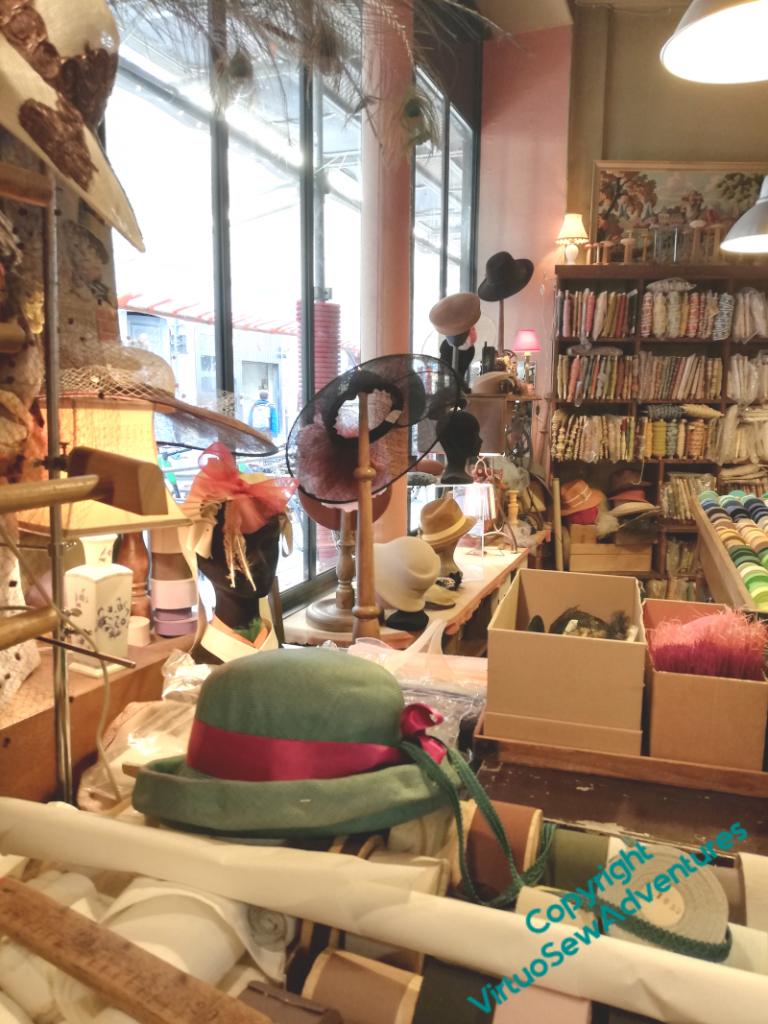
Ultramod – Hats 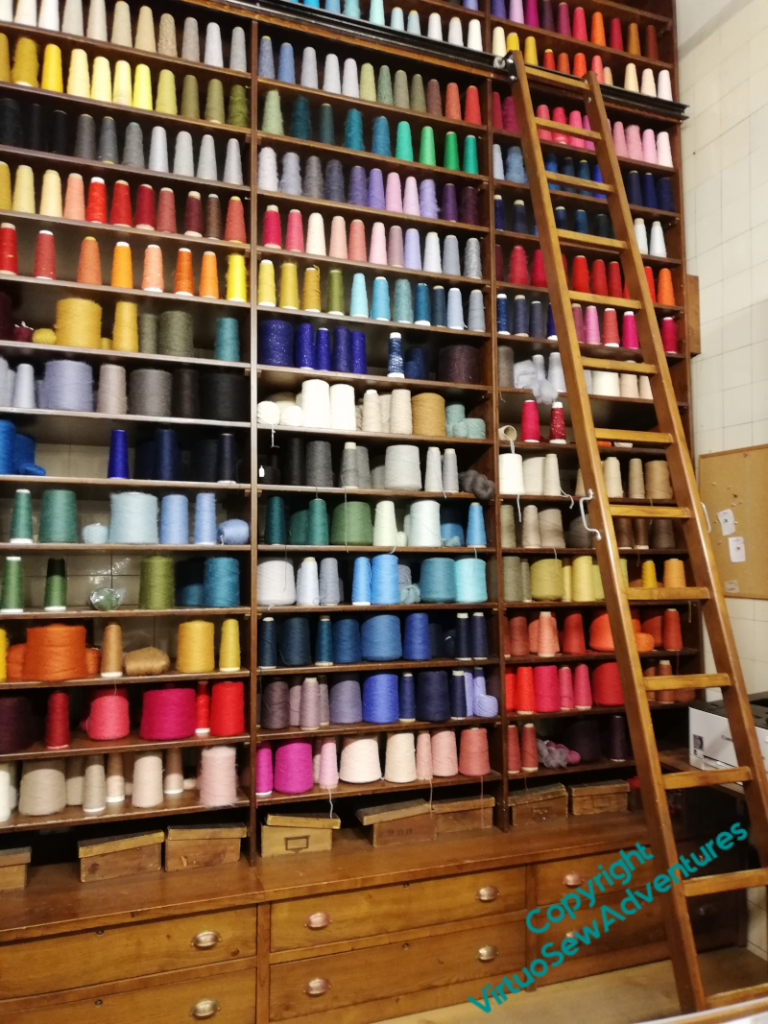
La Droguerie – Colour wall
We met at Metro Quatre Septembre, and Rebecca guided us to the various shops, telling us about the history of the atelier system and the particular histories of the various shops as we went. Even my non-embroidering engineer uncle found things to interest him – there was a poster for a manufacturer of sewing machines which pivoted (to use the modern term) to aero engines during the first world war! – but in fact, all of us found something to respond to our particular interests.
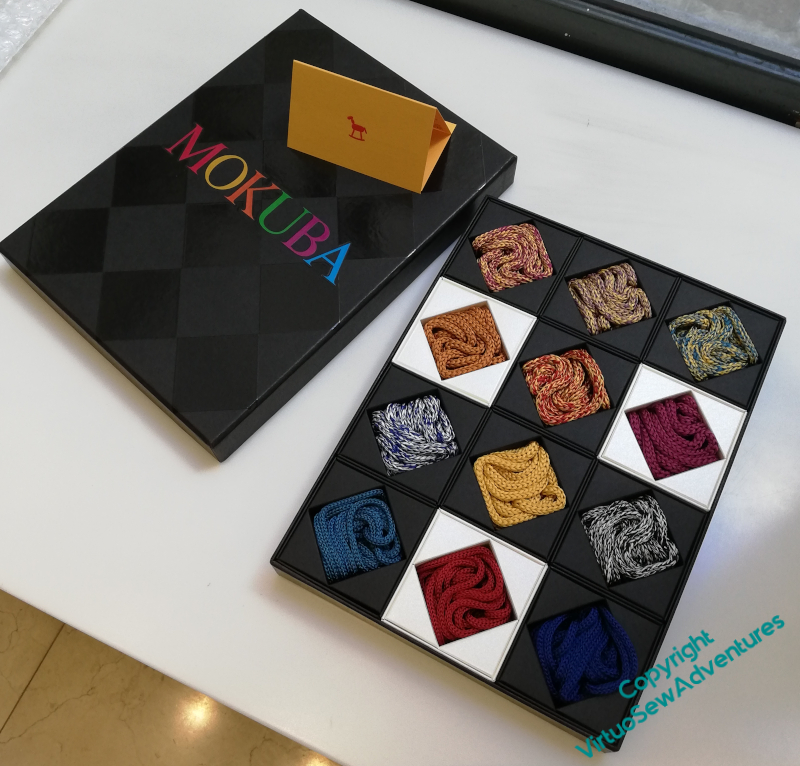
Mokuba Collection 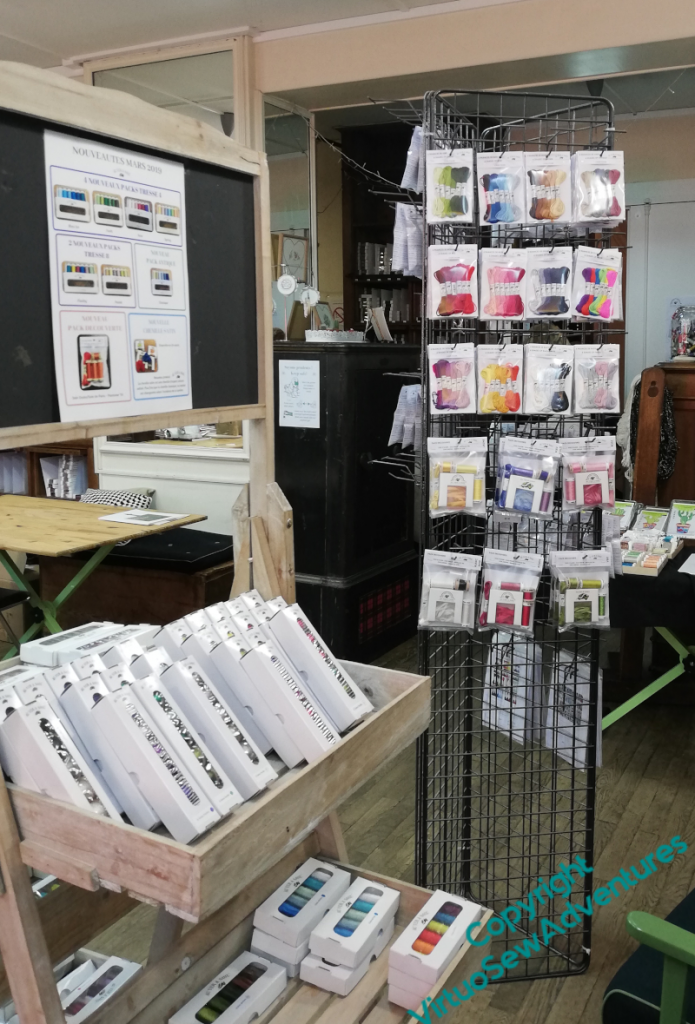
Au Ver A Soie 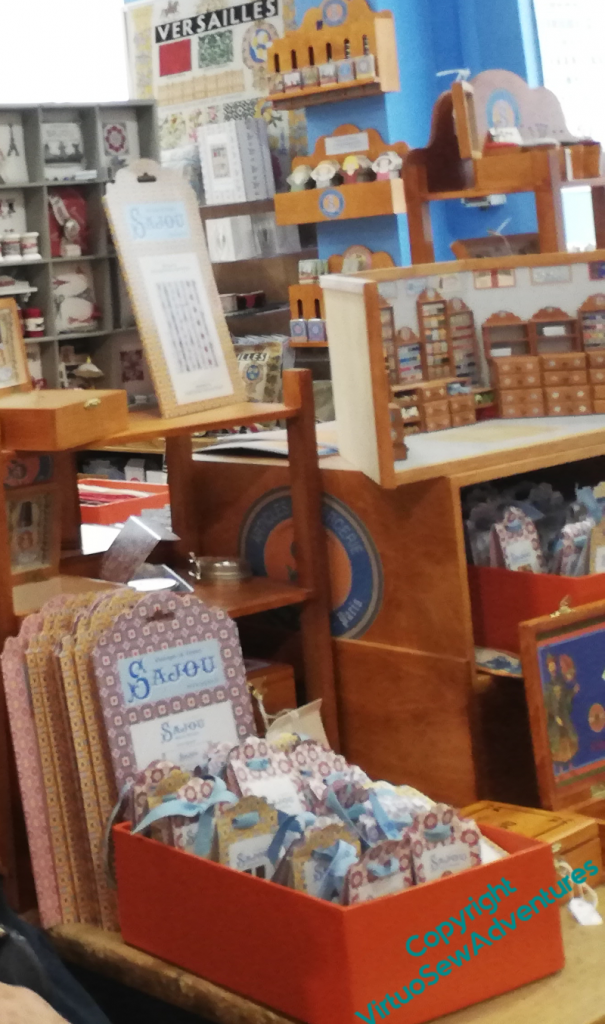
Boutique Sajou
The shops are all very different, and now I’ve visited them I will be better prepared for another visit, perhaps with plans in mind. What they share is knowledgeable and enthusiastic staff – in fact one of those in Au Ver A Soie is doing an RSN course. Online, in these days, naturally, but it was a great delight to see someone else’s work, if only on their phone.
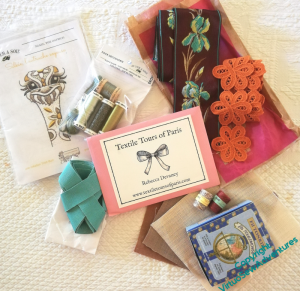
If you get a chance, when travelling is easier, do take a tour with Rebecca. She’s delightful, knowledgeable, and enthusiastic, and the extra bits and pieces of information you have, not to mention some sense of all the interesting materials you can find, are all well worth the effort.
As you can see, I was fairly restrained in my purchases, because I had not travelled with extra suitcase space, or planned in advance. The grosgrain ribbon matches the stone in my engagement ring, the brown ribbon with irises is for a hat, and so is the orange flower lace, the silk thread from Au Ver A Soie and the fil dentelle from Sajou are just to play with, and the little ostrich kit is my entertainment for the period between Christmas and New Year!
And in other news, Episode 27 of SlowTVStitchery is now live, and discusses reaching an important turning point, and the delights of solving embroidering puzzles.
Thinking about the stag for the Vision of Placidus
I’ve already mentioned that, although I have more yet to do on the Dreams of Amarna, I have little thoughts, now and again, about my plans for the next Really Big Project, the Vision of Placidus, inspired by Pisanello’s “Conversion of St Eustace”, Elizabeth Goudge’s “Herb of Grace”, my mother’s fine binding of “The Wind in The Willows”, and the kingfisher I saw at Flag Fen. Oh, and the “Chasse a la licorne” tapestry in the Musee de Cluny.
The Stag with the crucifix in his antlers is going to be the major character, and while I know I’m tearing into a genius of the past, I think Pisanello’s stag is a bit too tame for the story…
My first thought was to start from Sir Edwin Landseer’s Monarch of the Glen. After all, he’s full of personality and presence, and a recognisable figure to add to the layers of meaning and reference. But no, I think the crucifix won’t settle well into the antlers, and the pose isn’t quite right, either….
Then I spent more time rummaging online for pictures of stags, and came up with another to try. I like the challenging, direct stare of the pose here, but it puts the onlooker in the position of Placidus (according to the stories, he took the name “Eustace”, or more probably a Latin variant thereof, when he became a Christian), and I want Placidus to be in the picture. That said, he was a second century Roman, and I’m intending to dress him in florid fourteenth century dress, so don’t expect too much accuracy…
My next thought came from a book about the landscapes of Capability Brown that I bought for my cousin for Christmas. I’ve told her about the plans for Placidus, and she opened her gift, leafed through it, and then turned the book to me and said “Would this help?”
This is by no means the first time my cousin has helped me with design planning – it was talking to her that enabled me to crystallise the ideas for the Dreams of Amarna – and I like the photo enough to have three attempts at it. I still don’t think I’ve got it right. That said, all of these sketches have allowed me to think, not just about the pose, but about how I will use my threads to create the effect I want, of the illumination in the scene emanating from the crucifix.
A good use of time, even if not a stitch was set!
Great Lady’s Magazine Stitch-Off – 2
Sigh.
The pashmina, when it arrived, was a lovely caramel colour, with rather unanticipated silver spots on it, and it was a good deal flimsier than I was expecting. The others I have are all in fairly sturdy twill weaves. In truth, I’m not sure that would be easier, and if I ever finish this one, I may choose to find out..
Regular and long term readers of my blog will be aware that I have a thing about scale – scale of thread, scale of stitch, scale of weave. I’ve even discovered – much to my surprise – that the dreaded Plaited Braid Stitch isn’t always easier when it’s stitched wider and longer. So it will be no surprise that I spent a bit of time playing with various different threads to see what I thought of them, before settling on a final choice.
Scale isn’t the only concern, either. The right texture and sheen matter as well.
In the end I have settled on silks. The Medici yarn might have worked if I had had more of it, but I don’t think it is even made any more. The Appletons crewel wool was too heavy, and the Gumnut yarns (although I love them) somehow didn’t settle in comfortably.
Now I have to unpick my experiments and get started. I already have a newfound respect for any lady of the period who embroidered her muslin dresses, or her silk gauzes. There’s a story that Jane Austen embroidered a muslin dress with satin stitch spots, and the mere idea gives me cold shivers!
Although I doubt they had to contend with stuck-on paillettes!
The Great Lady’s Magazine Stitch Off
Rummaging around on Twitter, I found a most intriguing idea. A research team at the University of Kent, headed by Dr Jennie Batchelor (@jenniebatchelor on Twitter), is investigating the content and development of an eighteenth century periodical, The Lady’s Magazine. The magazine was sold with pull-out song sheets – and pull-out designs for embroidery. Generally speaking, they don’t survive, having been pulled out and used as they were intended to be.
But recently, a bound volume of a half-year (1796) came to light, with some patterns included. A little more discussion, the idea arose of scanning those designs for modern stitchers to play with, and The Great Lady’s Magazine Stitch-Off was born. For more on that, visit the project’s blog post on the subject.
I couldn’t resist the idea. I’ve downloaded the first five designs, and started to stare at them thoughtfully. The project suggests that stitchers might like to work modern versions as well as in some cases working versions which are as historically accurate as possible, so there is going to be quite a variety to look at.
I’ve decided that I’m going to work the designs on a pashmina shawl, and while I am waiting for it to arrive, I’m contemplating what I might choose to do, from highly modern needle-felted versions, to more or less classical embroidery.
I wanted to share it with you before I started stitching, because the vagaries of the post may substantially delay my first stitch, and a few of you may want to join in. Do let the project know if you do, they’re really enjoying what they’ve been seeing!
Update: They have recently posted their first round-up of Stitch Off contributions and planned contributions.
More to play with..
Recently we had a visit from some Portuguese friends, who we last saw when we were in the Azores. They had obviously remembered my delight when I found the embroidery shop in the main square at Punta Delgarda, because for their hostess gift, as well as bringing some coffee and olive oil, they brought a set of vintage Portuguese sewing and embroidery patterns!
Although they look like magazines, each one is in fact a large sheet that unfolds to provide drawn-out patterns for a multitude of types of embroidery, including surface embroidery, appliqué, cutwork and drawn thread work, some of it crisp and simple, some of it bright, colourful and really quite ornate. Suggested applications for the designs appear as well, so next time my inspiration flags (er, and I’ve finished the Azorean Cutwork!), I will be able to leaf through these to refresh it!
The coffee was presented in this paper bag, which is printed with a design that our friends told us is inspired by a traditional embroidery pattern from northern Portugal. They said they were disappointed not to have found some embroidery for me, but in some ways, I think this is even better.
One of these days I will be able to play with this design, and maybe reinterpret this traditional style in my own way.
I’m looking forward to that!
A real treat
Last week, not less than three of my assorted interests combined to give me a real treat.
The Queen’s Gallery in London is holding an exhibition called “In Fine Style“. The exhibition uses portraits of the Tudor and Stuart period to show the changes in fashion during the period, and there was a lot of embroidery and passementerie used, so the painters had a lot of scope. I’m interested in painting, too, so I’m always intrigued to see how a painter depicts texture, structure, and colour. Furthermore, major exhibitions these days often have additional events – not just a Private View on opening, but outreach events for schoolchildren, evening openings, tie-in events with other artists. An additional event caught my eye – an evening opening, followed by a recital of the music of John Dowland (contemporaneous with the paintings) given by the lutanist Jakob Lindberg.
Now, I’m an early music girl, so what with the chance to be nose-to-nose with some famous paintings and then to listen to music of the period surrounded by paintings of the composer’s assorted patrons…
I had a great time. There were some very familiar paintings – Elizabeth I as a princess, in a rose-red gown, with sleeves dripping gold embroidery, and a couple of pearl pendants you could swear you could pick off the canvas, van Dyck’s triple portrait of Charles I, Frances Stuart looking seductive in satin, with an entirely superfluous billow of fabric behind her. Familiar in reproduction, and fabulous. But, my goodness, the painting is even better when you can see it for real! Fur, gold thread, damask figured weaves, embroidery, gleaming pearls, glinting gems.
Then there were some unfamiliar ones. Edward IV, who I’ve read described as a blond beautiful giant, six foot tall, charismatic and something of a party animal. The portrait showed me a thin-faced, introspective man with dark red hair and a marked resemblance to the famous portrait of his brother Richard III – I suppose sitting for a portrait encourages introspection. Frances Stuart, in a buff coat like a man’s, her hair dressed to look like a man’s wig. Various unnamed men and women in the fashions of their time, in masque dress, fashionable clothes, clothes to make a statement. One lady wore a beautiful embroidered gown with a silvery gauze overdress set with crystals – imagine how many tiny brushstrokes you would need to bring a single crystal to life!
There were also some real examples – an embroidered jacket (not the Margaret Laton jacket, but very like it), a nightcap, and some gloves. And a Casket. And what a casket. It had a whole grove of needlelace-leaved trees planted on its’ lid, not to mention a horde of people frolicking around the side. And if I’ve learnt anything it’s that my detached buttonhole stitch is nothing like fine enough or tight enough. Sigh.
And the evening wasn’t over yet – after gloating over all that fabulous painted and embroidered finery, the recital! Jakob Lindberg is a great lutanist and a charming and knowledgeable man, so his introductions illuminated the music, and entertained the audience as much as his playing did. Though I did find myself wondering whether the composer had so attentive an audience when he played in the courts of England and Denmark!
Some opportunistic research for the Vision of Placidus
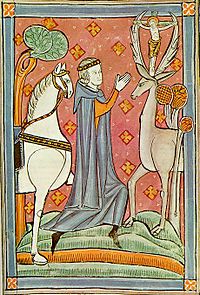
Conversion of St Hubert (Image from Wikipedia)
Shortly after I had my idea for a panel depicting the Vision of Placidus, I went to London for a lecture. The Pisanello is in The National Gallery, so after the lecture I took the opportunity, before catching the train home, to go to see the painting in real life. It turns out that St Hubert had a similar Conversion experience, so as well as the Pisanello “Vision of St Eustace” I found a fragment of an altarpiece entitled “The Conversion of St Hubert”…
I eventually tracked down the Pisanello, in the Sainsbury wing, and found it very much smaller than I expected – about A2 in size – which is much smaller than I am planning (about five foot by three foot). It was also just as dark as the reproduction I showed you in the first post about this idea. I sat down on a convenient window seat nearby, and started taking notes of the further research I need to do.
I will need picture references for
- a horse reined in from a gallop
- a stag with huge antlers
- hounds alert but not moving
- forest flora and fauna
- crucifix
- rocky outcrop
- suitably rich and exotic clothing for the huntsman
I also want to differentiate the vegetation from the background rather more, pull the rocky outcrop away from the background a bit more, and make the crucifix seem to grow out of the antlers rather more than it does in Pisanello’s painting.
While I was there, I sketched a very approximate idea of the space I want in the picture – the Pisanallo and the altarpiece, and the picture above, are all quite compressed and condensed, and at the moment my idea is to have much more space and “air” in the design.
When I got home I had another go, this time in pastels. Some elements of the pastel work quite well – the horse and its harness, and the crucifix between the deer’s antlers. Others are not so good – the trees in the background are too regularly spaced and too similar in shape, and, like the Pisanello, there isn’t as much space between the stag and the horse as I would like.
I need to be careful, here. If I concentrate too much on creating painted sketches, I might drive out all the stitching ideas, but at the same time, the more I think about the design, the better the chance I have of producing a panel I am happy with!


